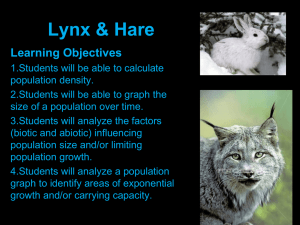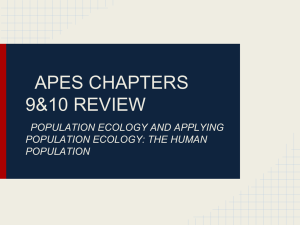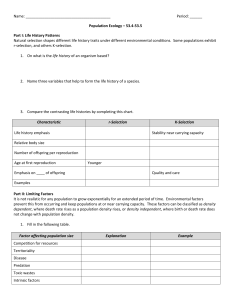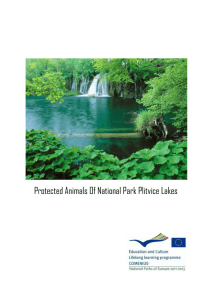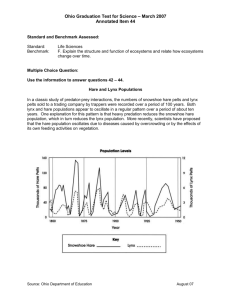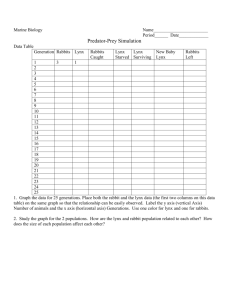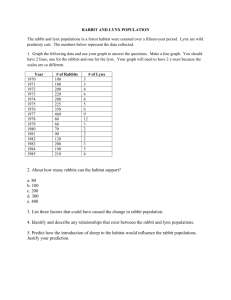Qualitative Mathematical Modeling: Loop Analysis
advertisement
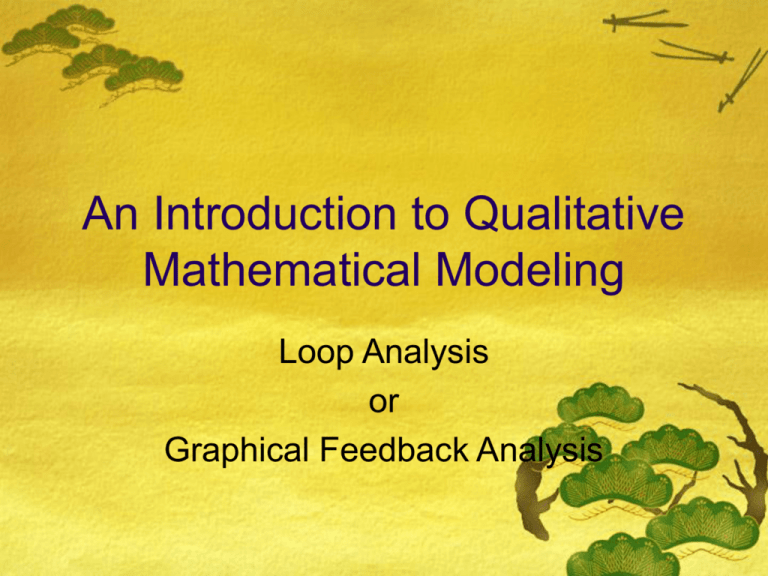
An Introduction to Qualitative Mathematical Modeling Loop Analysis or Graphical Feedback Analysis What is a Qualitative Mathematical Model? Crops Plants Pests farmer Graph theory E.g., The Familiar Influence Diagram Shows relational aspects of cause & effect: how variables interact. Loop Analysis is much more powerful than an influence Diagram. Derived from Graph Theory But in addition to relational analysis Depicts the effect of one variable to the next in terms of qualitative values of feedback. Shows the direction of feedback paths through the community If you can draw, you can Model! Signed directed graphs. Arrows Indicate direction (+, 0, -) Qualitative signs denoting effect The Making of a Loop Analysis Model (a Signed Digraph) A Signed Diagraph depicts a community and its interactions It comprises nodes (variables) which represent members of the community. Community is linked by interactions among its members. Pointed and blunt arrows show the direction of the effect of one variable on the next. (effect = feedback) curved arrows denote density-dependence &/or imply influences variables not implicitly stated in model. Node + feedback - feedback Self Loops - + - + Self Loops: density-dependent effects Negative self-loops self-regulate population growth (can mean its growth regulated by a community subsystem) Positive Feedback increases Feedback (e.g. numerical response to prey concentration...economic bubble) Basic Community Interactions INTERFERENCE COMPETITION PREDATOR-PREY - + MUTUALISM + + COMMENSALISM + AMENSALISM - - - EXPLOITATION COMPETITION + + - MICROBIAL CULTURE Drawing Rules and Suggestions page 1 Their can be only one interaction link from one variable to the next. Because the interaction link (coefficient) represents the net effect of one species upon the other. Therefore aspects of competition & predation, etc. are combined in the sign Rules and Suggestions Page 2 As a general rule, negative self-loops should be attached to most variables. It represents a density-dependent self regulatory effect. It may also imply that there are other variables that may be controlling its density but are not explicit in the model Remember that density-dependence among variables is expressed in material & energy transfer in the model Computer Does the Rest Transforms the digraph into a matrix Converts the signs of the interaction coefficients to cardinal values. Performs the matrix Algebra Provides estimates stability of community structure sign stability robustness of model to differences in interaction strength (relative differences can be important) -a11 Transformation of Signed Diagraph to a matrix 1 Lynx - +a12 2 Hare -a22 aj = “source”species -a21 ai = “target” species -a11 -a12 a21 -a22 effect of variable j on i Numeric Substitutions for signed Coefficients Reactors =ai Actors = a j Hare Lynx Hare -1 -1 Lynx +1 -1 A tour of the Software Go to http://www.ent.orst.edu/loop/ Formal mathematical details to follow in next chapter Build Signed Diagraph Using Powerplay symbol pallette Finish digraph then Click “Loop Analysis” button to get output Click here! “Show Matrix Output” Check digraph & matrix. Check Hurwitz Criteria for structural stability see details next slide Hurwitz Criteria I For local stability, all feedback must be negative. because of sign conventions in the use of matrix algebra. The term “positive” is used to express this condition. (Criterion I) Feedback at different levels (size of loop as determined by the number of variables linked in a path) is calculated and listed as the coefficients of the “characteristic polynomial” (more later) Qualitative Responses to Perturbation + feedback 0 feedback N* + N N* = pop’n at equilibrium - feedback Perturbation Time Hurwitz Criteria II quick explanation (more later) Hurwitz (a steam engine expert) found that an overreliance on safety valves that involved cycles containing many variables (higher level feedback) would lead to exploding engines. Higher numbers of negative feedback should be distributed at lower levels (smaller pathways, smaller numbers of variables per cycle) Cleverly, he used the coefficients of the characteristic polynomial to gain this insight. Stability Metaphor Local Stability Global Stability Neutral Stability = 0 feedback -a11 1 -a11 1 a12 1 -a21 a12 -a21 1 variable 2 2 1 cycle or Loop 2 variables 2 variables -a11 1 cycle -a21a12 2 cycles -a11 -a21a12 NOTE: LOOP = PATH RETURNING TO ITS ORIGIN CROSSING A VARIABLE ONLY ONCE ADJOINT, ABSOLUTE & WEIGHTED PREDICTIONS MATRICES SIMPLE EXPLANATION ON NEXT SLIDE Adjoint and Absolute Matrices The ADJOINT MATRIX comprises complementary feedback cycles & used to calculate (predict) the net effect of external input upon each and every member of the community. (e.g., what is the effect of liming acidified watersheds?) The ABSOLUTE MATRIX accounts for the total number of both + and Cycles (i.e. loops). It will be used to weight predictions (net effect). IF a new equilibrium value is predicted from the interaction of 55 (+) and 45 (-) cycles, the net is a change of 10 +. Is the net sufficient to predict an increase in standing crops from the external stimulus? We use weighted values to determine the confidence of sign stability for each community member (Next slide) Weighted Matrix The WEIGHTED MATRIX is calculated by dividing each variable in the ADJOINT MATRIX is by its representative in the ABSOLUTE MATRIX In this example the variable in question has a weighted value of (55-45)/100 = (0.1) & from our simulations unlikely to be Sign Stable. This then is a measure of predictive reliability The prediction can be red down the column! Predictions of Negative Input(s) Lynx Hare -1 -1 +1 -1 Trapping Lynx decreases lynx & increases hare. Trapping Hares for fur decreases both critters Trapping both species really decreases Lynx (-2) but doesn’t affect Hares (+1 -1= 0) You can add across the columns on the same row to get the joint effect of two inputs. Great heh? Test of Robustness Strengths of Interactions matter. Read next slide Strengths of Interaction Some topologies (structural properties) of communities can become stable or unstable depending upon the relative differences in the values of the interactive coefficients among “species”. Some model communities that pass both Hurwitz Criteria given Cardinal values will fail one or both criteria when randomly assigned Ordinal values of different strengths. This is a test of robustness & reliability of stability and predictive outcome of qualitative models. Run this test several times to get statistical values for models prone to fail. Check out published webs You can run many published models already loaded into the freeware. To test how the behavior of models are affected by self-loops you have the option of just putting self-loops on the base variables of the food web or in addition, putting self-loops on consumers as well.
